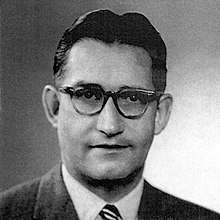Richard Leibler
Richard A. Leibler (March 18, 1914, Chicago, Illinois – October 25, 2003, Reston, Virginia) was an American mathematician and cryptanalyst. Richard Leibler was born in March 1914. He received his A.M. in mathematics from Northwestern University and his Ph.D. from the University of Illinois in 1939. While working at the National Security Agency, he and Solomon Kullback formulated the Kullback–Leibler divergence,[1] a measure of similarity between probability distributions which has found important applications in information theory and cryptology. Leibler is also credited by the NSA as having opened up "new methods of attack" in the celebrated VENONA code-breaking project during 1949-1950;[2] this may be a reference to his joint paper with Kullback, which was published in the open literature in 1951 and was immediately noted by Soviet cryptologists.[3]
Richard Leibler | |
|---|---|
 | |
| Born | March 18, 1914 Chicago, Illinois |
| Died | October 25, 2003 (aged 89) |
| Alma mater | Northwestern University (A.M., Mathematics) University of Illinois (Ph.D., Mathematics, 1939) |
| Known for | Kullback–Leibler divergence |
| Scientific career | |
| Fields | cryptanalysis, mathematics |
| Institutions | United States Navy, Princeton University, National Security Agency, Institute for Defense Analysis |
He was director of the Communications Research Division at the Institute for Defense Analyses, a captive think tank for NSA, from 1962 to 1977. He was inducted into the NSA Hall of Honor for his efforts against the VENONA code.[4]
References
- Kullback, S.; Leibler, R.A. (1951). "On information and sufficiency" (PDF). Annals of Mathematical Statistics. 22 (1): 79–86. doi:10.1214/aoms/1177729694. MR 0039968.
- Robert Benson, The Venona Story NSA publications
- Suhov, Y and Kelbert, M Probability and Statistics by Example vol 2 (CUP, 2008) p433
- "Gene Grabeel" (PDF), NSA History Today, p. 30, 17 June 2014, retrieved 2015-05-15